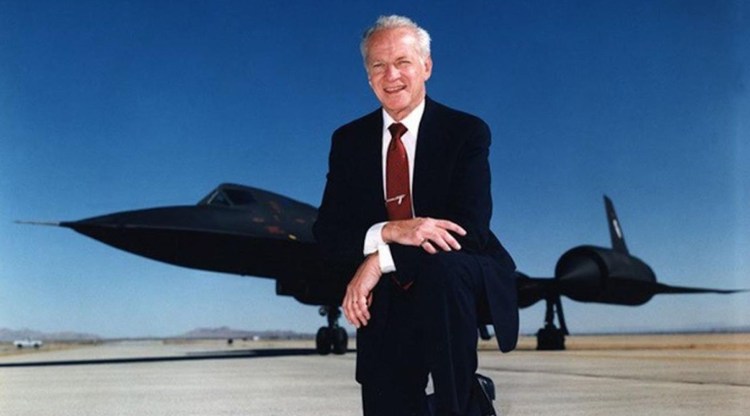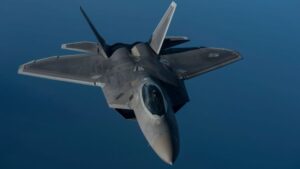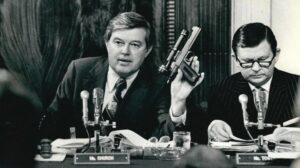Chosen as the subject of today’s SOFREP Pic of the Day is Benjamin Robert Rich, a giant in American military aviation.
The Father of Stealth
Rich, often hailed as the “Father of Stealth,” is a towering figure in modern military aviation. As the director of the famed Lockheed Martin Skunk Works division, Rich spearheaded some of the most groundbreaking aerospace projects in U.S. history, transforming ideas into realities that reshaped air combat. His legacy is tightly interwoven with the development of stealth technology, a game-changing advancement that has given the United States military a significant edge over its adversaries.
Born in 1925 in Manila, Philippines, and raised in the U.S., Rich’s passion for aviation took flight early in life. He graduated from the University of California, Berkeley, with a degree in mechanical engineering and later earned a master’s in aeronautical engineering from the University of California, Los Angeles (UCLA). Rich joined the illustrious Lockheed Aircraft Corporation in 1950 when the Cold War fueled rapid advancements in aerospace technology.
Early Career and Rise at Lockheed’s Skunk Works
At Lockheed, Rich initially worked under Clarence “Kelly” Johnson, the legendary founder of the Skunk Works division. Johnson was known for his work on the U-2 spy plane and other cutting-edge projects, and Rich was an eager learner. His talent quickly earned him recognition, and by the mid-1970s, he was positioned to succeed Johnson as head of Skunk Works.
During his leadership, Rich made his most significant contribution: the development of stealth technology. The idea of making aircraft invisible—or at least challenging to detect—by radar was not new, but it was Rich who turned the concept into a reality. He led the design and development of the F-117 Nighthawk, the world’s first operational stealth aircraft, which was shrouded in secrecy until revealed to the public during the Gulf War in 1991. The success of the F-117 in evading radar detection and executing precision strikes in heavily defended areas solidified Rich’s legacy.
Stealth technology reduces an aircraft’s radar cross-section (RCS), making it harder for enemy radars to detect the plane. Rich’s team at Skunk Works pioneered methods that allowed planes to “disappear” from radar screens through the innovative use of flat surfaces, radar-absorbent materials, and careful consideration of aircraft design. This achievement was a game-changer in military strategy, as it allowed the U.S. Air Force to penetrate heavily defended areas without being detected, giving American forces a distinct advantage.
Pioneering Stealth Technology and the F-117 Nighthawk
In addition to the F-117, Rich was instrumental in the development of other advanced aircraft, including the SR-71 Blackbird, a long-range, Mach 3+ strategic reconnaissance aircraft that was virtually untouchable at its operational altitude and speed. While the SR-71 was not a stealth aircraft in the modern sense, its speed and altitude made it difficult to track and intercept, showcasing another aspect of Rich’s innovative thinking.
Chosen as the subject of today’s SOFREP Pic of the Day is Benjamin Robert Rich, a giant in American military aviation.
The Father of Stealth
Rich, often hailed as the “Father of Stealth,” is a towering figure in modern military aviation. As the director of the famed Lockheed Martin Skunk Works division, Rich spearheaded some of the most groundbreaking aerospace projects in U.S. history, transforming ideas into realities that reshaped air combat. His legacy is tightly interwoven with the development of stealth technology, a game-changing advancement that has given the United States military a significant edge over its adversaries.
Born in 1925 in Manila, Philippines, and raised in the U.S., Rich’s passion for aviation took flight early in life. He graduated from the University of California, Berkeley, with a degree in mechanical engineering and later earned a master’s in aeronautical engineering from the University of California, Los Angeles (UCLA). Rich joined the illustrious Lockheed Aircraft Corporation in 1950 when the Cold War fueled rapid advancements in aerospace technology.
Early Career and Rise at Lockheed’s Skunk Works
At Lockheed, Rich initially worked under Clarence “Kelly” Johnson, the legendary founder of the Skunk Works division. Johnson was known for his work on the U-2 spy plane and other cutting-edge projects, and Rich was an eager learner. His talent quickly earned him recognition, and by the mid-1970s, he was positioned to succeed Johnson as head of Skunk Works.
During his leadership, Rich made his most significant contribution: the development of stealth technology. The idea of making aircraft invisible—or at least challenging to detect—by radar was not new, but it was Rich who turned the concept into a reality. He led the design and development of the F-117 Nighthawk, the world’s first operational stealth aircraft, which was shrouded in secrecy until revealed to the public during the Gulf War in 1991. The success of the F-117 in evading radar detection and executing precision strikes in heavily defended areas solidified Rich’s legacy.
Stealth technology reduces an aircraft’s radar cross-section (RCS), making it harder for enemy radars to detect the plane. Rich’s team at Skunk Works pioneered methods that allowed planes to “disappear” from radar screens through the innovative use of flat surfaces, radar-absorbent materials, and careful consideration of aircraft design. This achievement was a game-changer in military strategy, as it allowed the U.S. Air Force to penetrate heavily defended areas without being detected, giving American forces a distinct advantage.
Pioneering Stealth Technology and the F-117 Nighthawk
In addition to the F-117, Rich was instrumental in the development of other advanced aircraft, including the SR-71 Blackbird, a long-range, Mach 3+ strategic reconnaissance aircraft that was virtually untouchable at its operational altitude and speed. While the SR-71 was not a stealth aircraft in the modern sense, its speed and altitude made it difficult to track and intercept, showcasing another aspect of Rich’s innovative thinking.
Rich’s career was not without its challenges. Developing the F-117 and other advanced aircraft often required navigating complex military bureaucracy, securing funding, and convincing skeptics that his vision was achievable. However, his determination and the success of his projects proved the doubters wrong.
He remained the head of Skunk Works until his retirement in 1991, just after the public debut of the F-117. By that time, his reputation as the “Father of Stealth” was well established. In his memoir, Skunk Works: A Personal Memoir of My Years at Lockheed, Rich provided a detailed account of his experiences, offering insight into the clandestine world of advanced military aviation and the technological innovations that came out of Skunk Works during his tenure.
Benjamin Rich passed away in 1995, but his legacy endures in every stealth aircraft in operation today, from the B-2 Spirit bomber to the F-22 Raptor and the F-35 Lightning II. His work at Skunk Works didn’t just give the U.S. military a technological edge—it fundamentally changed the nature of air combat and military strategy.
For those of us interested in the world of military aviation, Rich’s story is a testament to the power of innovation and the importance of pushing the boundaries of what is possible. His visionary leadership at Skunk Works paved the way for the future of warfare, and the stealth technology he helped develop remains a key asset for U.S. forces in operations around the world.
—
Disclaimer: SOFREP utilizes AI for image generation and article research. Occasionally, it’s like handing a chimpanzee the keys to your liquor cabinet. It’s not always perfect and if a mistake is made, we own up to it full stop. In a world where information comes at us in tidal waves, it is an important tool that helps us sift through the brass for live rounds.



